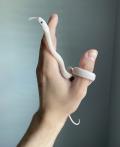» Site Navigation

0 members and 3,182 guests
No Members online
Most users ever online was 6,337, 01-24-2020 at 04:30 AM.
» Today's Birthdays

» Stats

Members: 75,096
Threads: 248,539
Posts: 2,568,740
Top Poster: JLC (31,651)
|
-
BPnet Veteran


hey everyone, i dont know that much about bloods but i do know that they are VERY thick, so my question was.... how hard is it to handle an adult ? do you even handle them or just take them out and let them crawl around.
-
-
Registered User

They have thick muscle and are relatively aggresive snakes. However, smulkin is in the process of taming his bloods. Try pm him.
-
-
Hehe - as adults they'll def need all the support you can give em in the lifting, heck at 18" our black blood is girthy enough I don't like lifting him with a single hand, but he's uber-friendly and will just chill and slowly investigate you. Our reds on the other hand are a bit snappier, the young male has to be taken out with a hook and then transfered to hand but he needs some work as he's easily provoked, Kali the female is getting a lot better but she is still unforgiving of rapid movements near her or having anything looming above her (can't blame her I'm the same way until I gets me coffee).
"I don't FEEL tardy . . ."
-
-
BPnet Veteran


ever been bitten by one ? does it hurt alot ?
0.1 Albino Redtail Boa
0.1 Colombian Redtail Boa
0.2 Salmon Pastel Redtail Boa's
0.1 normal Ball Python
0.1 Ball Python.
0.1 Albino Ball Python
0.1 Amelanistic Corn Snake
1.0 Sonoran Gopher
1.0 Mexican black Kingsnake
0.1 Luecistic Texas rat snake
-
-
Banned

He actually posted up pictures of the bite marks before.
The ones that looked like kitty ears.
P.S - I did as you told, I gave my snake coffe ... its still nippy and uber hyper.
-
-
BPnet Veteran


OHHH YA !! im the one who asked to see some bite pics....haha DUH. 
0.1 Albino Redtail Boa
0.1 Colombian Redtail Boa
0.2 Salmon Pastel Redtail Boa's
0.1 normal Ball Python
0.1 Ball Python.
0.1 Albino Ball Python
0.1 Amelanistic Corn Snake
1.0 Sonoran Gopher
1.0 Mexican black Kingsnake
0.1 Luecistic Texas rat snake
-
-
Registered User

 Originally Posted by Brandon.O
hey everyone, i dont know that much about bloods but i do know that they are VERY thick, so my question was.... how hard is it to handle an adult ? do you even handle them or just take them out and let them crawl around.
Hi I'm new here. Here's a good resource to help answer your questions. 
Handling:
Once a young blood has been feeding regularly for six to eight weeks, it is a good time to start handling it. It s recommended to handle a blood as little as possible until it has acclimated very well after a good deal of time, except for cage cleaning. Youngsters will typically have little patience when handling them, and will always let you know when a handling session is over by either defecating, hissing or biting. Use of a glove is helpful (although in some cases gloves may make the snake more defensive because there is a larger object approaching them), as it does help them get used to the transition of being handled without being subjected to another heat source at which to strike. You should always approach a snake from behind the head, as a head-on approach will scare. It s always necessary to handle this snake with two hands, even though it doesn t have great length. Bloods have a lot of girth and don t have the dexterity of a common boa, so it s important to provide as much support as possible. A full grown blood can not wrap around your wrist like a ball python can, with little or no support from the handler.
It s important to have confidence when picking up these critters. If done so correctly, very few bloods will react with a defensive bite. (Remember, most snake bites occur because the snake is either afraid, or because the handler smells like food. You d be surprised at how many reports of snake bites have to do with an inexperienced or negligent handler.)
If it s a young blood, begin slowly at the mid-body with a scooping type of motion. A snake will usually move its body upward, allowing you to get underneath it. (However, sometimes they might not budge, or specifically nudge you in the opposite direction, showing you that they might not feel like being handled. This is a good reference point for observing behavior, as far as notating it and being aware if there are other things to be concerned about. For example, if you have a blood that loves being handled all the time, always welcoming your warm hands, then one day it nudges you the other way, it may be a sign to the handler that it s time to check the records for its last shed, to check the cage s humidity and temperature, or even give the snake a visual examination the next time you handle it. All of these astute observations will make you a great keeper, not to mention, prevent a number of challenges.)
For adults, place one hand 1/3rd of the way down the body and then the other hand appropriately placed between your hand in use and the tail. This should be adequate to hold the blood. Of course, never try to control the head while handling. You will more than likely get a defensive reaction. Many people like to check if a snake is head shy by playing with or constricting its head movement. This is not recommended, it yields small benefit (if any), and doing so should be regarded with caution. (How did you react the last time someone put you in a headlock ) Hold securely, but allow for the snake to move freely. It s important to distribute the weight of an adult abundantly when handling simply because of their size. A tight grip or too much pressure from hands holding at concentrated points may lead to injuring an internal organ, constricting the lungs, or more. Don t mistake a short length snake for a milk snake. A 25 to 35 pound snake deserves a lot of respect, and support. Two sets of hands are a good idea as well as using your arms to distribute its weight, and not just two narrow hands. (Is it more comfortable to lay on a stair case, or a bed )
It s also a good idea to even pet or stroke the latter half of the snake before handling (like a dog). My snakes know exactly when it s time to be handled by the way I feel them before I pick them up. Smelling freshly washed hands (especially in between handling reptiles) and feeling a deliberate smooth stroke down the latter half of their body prepares them for a little activity. A gentle approach will always win compared the enthusiast who insists on showing the snake who s boss by picking it up fast and rough. The only thing being proven would be that the snake can be picked up quick, and probably not too comfortably. Perhaps it would be beneficial to handle a more aggressive snake (like an Anaconda) quickly, but this approach is not needed, nor encouraged with the timid blood python. Confidence can be construed gently, and without scaring the daylights out of the snake. If you re in a rush, save handling for a later time. Always confident, patient, and conscientious, a slow yet deliberate approach will gain much trust with your blood for handling, as well as shape its temperament into a playful (not defensive) one.
Copyright 2004 Todd Schaefer All Rights reserved.
Copyright 2004 www.herpcenter.com All Rights reserved.
http://www.herpcenter.com/Blood_Pythons.php
-
-
BPnet Veteran


Welcome to the forums Drdst8! Thanks for the info 
- Carson
Compadres, it is imperative that we crush the freedom fighters before the start of the rainy season. And remember, a shiny new donkey for whomever brings me the head of Colonel Montoya.
-
-
BPnet Veteran


Great info! Thanks for posting it. I cleaned up the random question marks for you. Glad to have you join us here.
3.1.1 BP (Snyder, Hanover, Bo Peep, Sir NAITF, Eve), 1.2.3 Rhacodactylus ciliatus (Sandiego, Carmen, Scooby, Camo, BABIES  ), 1.0 Chow (Buddha), 0.2 cats (Jezebel, PCBH "Nanners"), 0.3 humans ), 1.0 Chow (Buddha), 0.2 cats (Jezebel, PCBH "Nanners"), 0.3 humans
xnview for resizing and coverting pics
Support Ball-Pythons.net by shopping our store!
-
-
Banned

:o that is some really handy information, THANKS!
And welcome to this wonderful forum! 
-
 Posting Permissions
Posting Permissions
- You may not post new threads
- You may not post replies
- You may not post attachments
- You may not edit your posts
-
Forum Rules
|